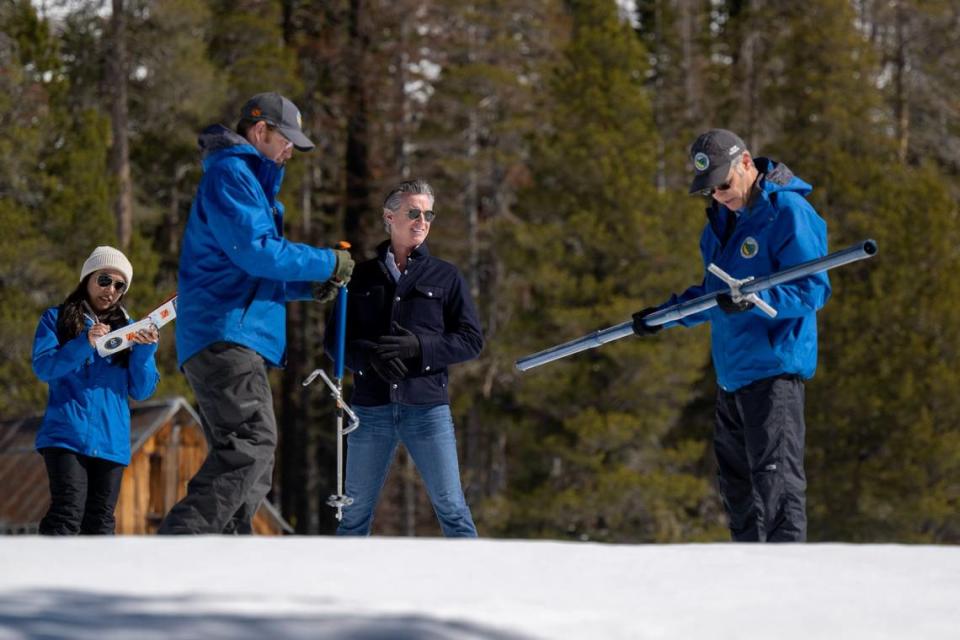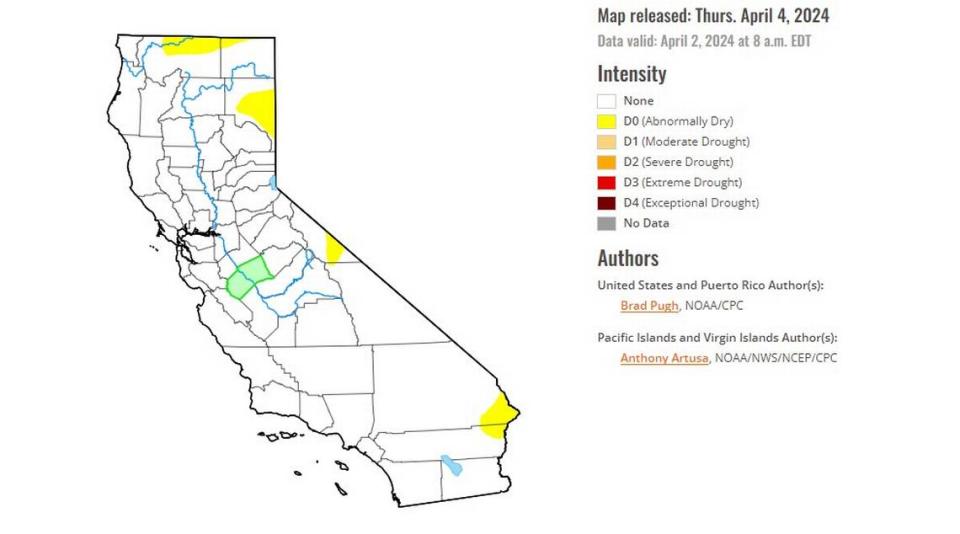How full are major California reservoirs as state exits another wet winter?
The majority of California’s reservoirs are above their historic average levels following the end of two wet winters.
The state’s largest reservoirs, Shasta Lake and Lake Oroville, were measured at a respective 118% and 122% of their averages for early April, according to data from the California Department of Water Resources.
Folsom Lake in the Sierra Nevada foothills exits early April at 116%.
Only two reservoirs, San Luis in western San Joaquin Valley and Castaic in Southern California, were below average.
San Luis Reservoir was at just 87% and much smaller Castaic Lake in Los Angeles County was at 92%.
Here’s the status of California’s 17 major reservoirs as of midnight on Thursday, April 9, according to data from the California Department of Water Resources:
Shasta Lake - Shasta County
Percent of historic average: 118%
Percent of total capacity: 95%
Lake Oroville - Butte County
Percent of historic average: 122% Percent of total capacity: 89%
Trinity Lake - Trinity County
Percent of historic average: 110% Percent of total capacity: 82%
Lake Sonoma - Sonoma County
Percent of historic average: 111%
Percent of total capacity: 70%
San Luis Reservoir - Merced County
Percent of historic average: 87%
Percent of total capacity: 74%
Cachuma Lake - Santa Barbara County
Percent of historic average: 131%
Percent of total capacity: 100%
Lake Casitas - Ventura County
Percent of historic average: 118%
Percent of total capacity: 98%
Castaic Lake - Los Angeles County
Percent of historic average: 92%
Percent of total capacity: 79%
Diamond Valley Lake - Riverside County
Percent of historic average: 120%
Percent of total capacity: 90%
New Bullards Bar Reservoir - Yuba County
Percent of historic average: 112% Percent of total capacity: 89%
Folsom Lake - Sacramento, El Dorado and Placer counties
Percent of historic average: 116% Percent of total capacity: 77%
Camanche Reservoir - Amador, Calaveras and San Joaquin counties
Percent of historic average: 135% Percent of total capacity: 86%
New Melones Lake - Calaveras and Tuolumne counties
Percent of historic average: 136% Percent of total capacity: 84%
Don Pedro Reservoir - Tuolumne County
Percent of historic average: 111% Percent of total capacity: 84%
Lake McClure - Mariposa County
Percent of historic average: 130% Percent of total capacity: 72%
Pine Flat Reservoir - Fresno County
Percent of historic average: 149% Percent of total capacity: 82%
Millerton Lake - Fresno and Madera counties
Percent of historic average: 121% Percent of total capacity: 86%
A boosted snowpack and ‘abnormally dry’ conditions
An update from the U.S. Drought Monitor last week shows a few portions of California remain “abnormally dry.”
A weekly map that illustrates drought intensities across the country shows the state’s “abnormally dry” status has not budged from 4.5% since March 5.
That’s an improvement from 7% on Feb. 27.
The state’s boosted snowpack and a strategic water plan could help kick the remaining dry spots.
After a dry start to the water year, which began Oct. 1, the fourth and final manual snow survey showed an above-average snowpack for the second season in a row, according to a news release from the California Department of Water Resources.

“California has had two years of relatively positive water conditions, but that is no reason to let our guard down now,” said state climatologist Michael Anderson with the California Department of Water Resources.
“With three record-setting multi-year droughts in the last 15 years and warmer temperatures, a well above average snowpack is needed to reach average runoff,” he said in the release, warning the state’s future water years will “see more extreme dry times interrupted by very wet periods.”
The snowpack at Phillips Station, located west of Lake Tahoe, recorded 64 inches of snow last week during a snow survey by the state water agency. That’s 113% of the average for that location.
California reservoir levels stand at 116% of the average, according to the release.
The next focus is to capture as much snowmelt runoff as possible, state water officials say. The dry start to the year and soot and ash from burn scars could make that difficult.
California’s drought status
California is drought-free, similar to what was monitored in March 2020, according to the U.S. Drought Monitor.
No one has lived in drought conditions since November, a significant decrease from roughly 3,000 people in October and about 9,800 people in September.
Approximately 903,000 people remained in drought areas in August.

Roughly 4.5% of the state — parts of Siskiyou, Modoc, Lassen, Mono, Inyo, San Bernardino and Riverside counties — remained abnormally dry as of Tuesday, April 2, according to the U.S. Drought Monitor.
In February, the list included portions of Plumas, Sierra, Nevada, Placer, El Dorado and Alpine counties.
The state has been without “moderate,” “severe,” “extreme” and “exceptional” drought conditions since October.
What do you want to know about life in Sacramento? Ask our service journalism team your top-of-mind questions in the module below or email servicejournalists@sacbee.com.
